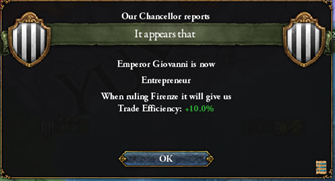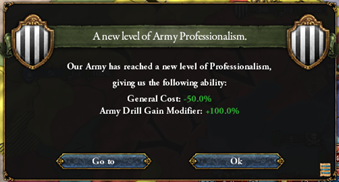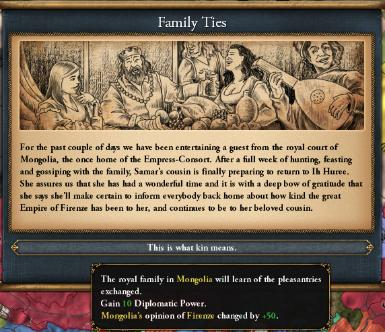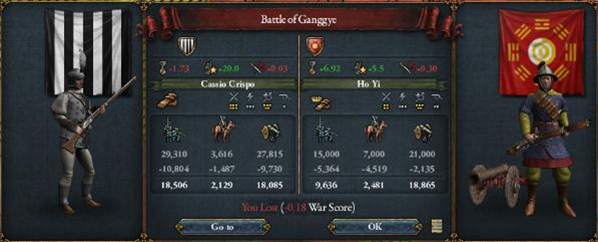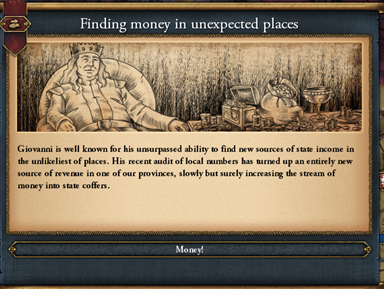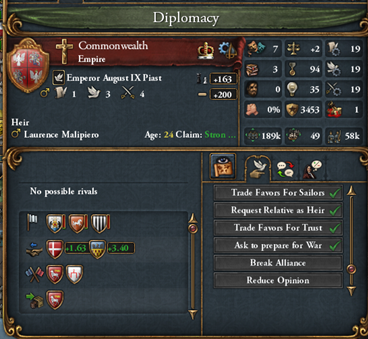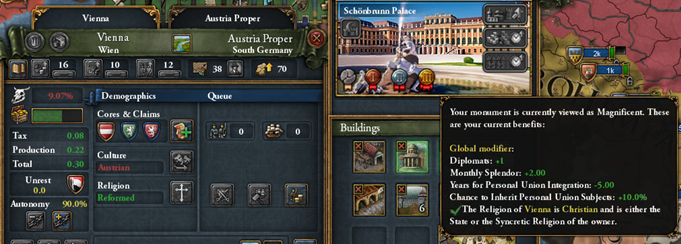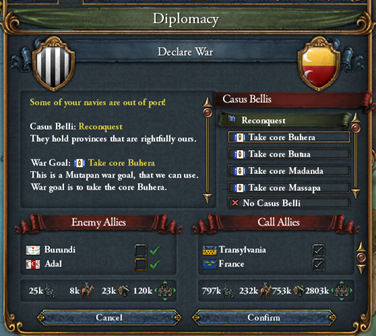Chapter 41 – The last waltz of the Sphinx.
Before Giovanni declared the war for his new wife’s country claims on Oirat, he realized that those were disconnected from Mongolia proper. The fastest and simplest way to reach those territories was through Jin, who held Mongolian cores. The emperor attacked the Chinese nation allied to Korea -but whose other friends Shu and Xi declined the call to arms- in August 1637.
The first battles in sea and land were victories for the Koreans, who repelled an amphibian invasion into their peninsula. The Florentine armies and navies were forced to withdraw to Yue’s provinces to rest and repair. Meanwhile, another war for the claims of Kongo was initiated against Kazembe. Giovanni kept looking for the most lucrative options for Firenze.
The constant drilling, sieges and battles -even the lost ones- teach important lessons that made the Florentine army completely professional.
To prove this point, Giovanni opened a third front in Southeast Asia, warring Ayutthaya for the provinces that they had taken from Khmer before the latter converted into a Florentine vassal. The African war ended shortly after, with the allies pacified for war reparations and Kazembe becoming part of Kongo. And the empress-consort birth country showed appreciation for the imperial effort to restore the territorial integrity of Mongolia.
The iron-clad defense from the Koreans was evidenced once more in the mountain fort of Ganggye, where they made bleed deeply the Florentine forces when it was about to be taken.
The war in Southeast Asia was pretty much over for quite some time, but Giovanni waited for Pagarruyung to fell to annul all their alliances. The next day, Ayutthaya returned every core province to Khmer, as well as a corridor through forts to connect Burma with China, being dismembered into five separated areas.
The Koreans had fought bravely, spending a fortune in expensive and numerous mercenaries since they had no manpower left in their ranks. When two more forts were taken, the emperor magnanimously only demanded their multi-fortified capital -to never have to take it again-, cancelling an alliance and their entire treasury, hoping for a bankruptcy. Left alone and almost completely occupied, Jin was forced to give back to Mongolia their provinces and claims. Finally at peace, Giovanni ordered the incorporation of Kongo into Firenze, since they were just above the threshold with relations strained after the other vassals’ integrations.
A couple of months later, and leaving the eastern regiments having a well-earned rest, Giovanni declared a war on the Mamluks, citing claims and old affronts. Their allies were the small nations of Harar, Marehan, and Sherwa on the Horn of Africa.
Then, in a move that surprised half of Europe, the emperor chose to enter in a conflict with Austria with the claims that Bohemia had. The Habsburg allies were Wurttemberg, Magdeburg, Landshut, and the trade power Lubeck. War started in March of 1642, with Wien as the price. There was no place where Giovanni did not make a profit.
In August, the Commonwealth Piast “emperor” passed, leaving the throne to his 15-year-old successor. Giovanni used the favors kept and maintained in their court to introduce a Malipiero as heir, if true that older than the current ruler. Since there was no alliance, a diplomat was maintained to recover those favors.
One by one the secondary participants left the war. Landshut was the first by annulling their alliances and giving their money. Shewa and Harar became Florentine territory so their capital forts in the mountains would never have to be sieged again. Marehan had been attacked by Mogadishu, and the emperor let them to absorb the former. The Lubeckers were giving trouble to the isolated imperial forces.

With the Egyptians alone and occupied, Giovanni sat at the negotiating table and made just demands: the provinces where Firenze had claims, including Cairo, and their treasury, they were already without friends. It was a better deal that the Mamluks could hoped for, far from what the emperor could have wanted, and quickly accepted. With the power of the seemingly endless Florentine coffers, the Al-Azhar university was developed to magnificent level in three days. And the pyramids were expected to follow the same fate once the province had become cored and populated with Syrian -an accepted Levantine- culture.
When Kongo turned into Florentine territory, their population was welcomed as another accepted culture. As such, the M’banza project could be utilized, and was quickly developed into the greatest level possible. Giovanni also repelled the noble privilege of strong duchies for the first time in centuries, reducing the members of the Foreign Affairs Office, but boosting the maximum accepted absolutism. He also noticed that the Poles had removed Laurence Malipiero as heir, and his favors in their court were far from being able to present another family member, unless the current ruler were to die.
To punish Lubeck for their insolence, the emperor cancelled their alliances, sacked their treasury, and kept their capital, center of trade and fort included. Austria -alone and completely occupied- surrendered all their forts to Bohemia, while Firenze kept Wien. The palace of Schonbrunn was in ruins, but Giovanni used the power of his gold to restore it, bigger and better than before. The generous effort set the basis for increased opportunities to inherit personal unions, added to the unbelievably high diplomatic reputation of the country and her rulers.
The integration of Air commenced in northern Africa. In the south, when the revived nation of Mutapa as a vassal in a single province needed to recover the rest of her cores, the emperor was more than willing to comply since the truce with Kilwa had just recently expired.
Luba is in the Air.
Luba is in the Air.

